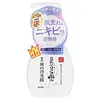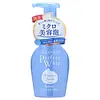What's inside
What's inside
 Key Ingredients
Key Ingredients

 Benefits
Benefits

 Concerns
Concerns

 Ingredients Side-by-side
Ingredients Side-by-side

Dipotassium Glycyrrhizate
HumectantWater
Skin ConditioningPotassium Cocoyl Glycinate
Butylene Glycol
HumectantSorbitol
HumectantGlycerin
HumectantDisodium Cocoamphodiacetate
CleansingGlycine Soja Germ Extract
EmollientGlycine Soja Extract
Skin ConditioningMagnesium Ascorbyl Phosphate
AntioxidantDisodium EDTA
Alcohol
AntimicrobialSodium Lauroyl Methylaminopropionate
CleansingPotassium Hydroxide
BufferingPhenoxyethanol
PreservativeDipotassium Glycyrrhizate, Water, Potassium Cocoyl Glycinate, Butylene Glycol, Sorbitol, Glycerin, Disodium Cocoamphodiacetate, Glycine Soja Germ Extract, Glycine Soja Extract, Magnesium Ascorbyl Phosphate, Disodium EDTA, Alcohol, Sodium Lauroyl Methylaminopropionate, Potassium Hydroxide, Phenoxyethanol
Water
Skin ConditioningSorbitol
HumectantGlycerin
HumectantDipropylene Glycol
HumectantButylene Glycol
HumectantSodium Methyltaurate
Skin ConditioningLauryl Betaine
CleansingLauric Acid
CleansingArginine Cocoate
Skin ConditioningPolyquaternium-7
Sodium Acetylated Hyaluronate
HumectantSodium Hyaluronate
HumectantSericin
Skin ConditioningMyristic Acid
CleansingPentasodium Pentetate
Sodium Metabisulfite
AntioxidantPotassium Hydroxide
BufferingBis-Ethoxydiglycol Cyclohexane 1,4-Dicarboxylate
EmollientCitric Acid
BufferingPotassium Sorbate
PreservativeTocopherol
AntioxidantSodium Benzoate
MaskingParfum
MaskingWater, Sorbitol, Glycerin, Dipropylene Glycol, Butylene Glycol, Sodium Methyltaurate, Lauryl Betaine, Lauric Acid, Arginine Cocoate, Polyquaternium-7, Sodium Acetylated Hyaluronate, Sodium Hyaluronate, Sericin, Myristic Acid, Pentasodium Pentetate, Sodium Metabisulfite, Potassium Hydroxide, Bis-Ethoxydiglycol Cyclohexane 1,4-Dicarboxylate, Citric Acid, Potassium Sorbate, Tocopherol, Sodium Benzoate, Parfum
 Reviews
Reviews

Ingredients Explained
These ingredients are found in both products.
Ingredients higher up in an ingredient list are typically present in a larger amount.
Butylene Glycol (or BG) is used within cosmetic products for a few different reasons:
Overall, Butylene Glycol is a safe and well-rounded ingredient that works well with other ingredients.
Though this ingredient works well with most skin types, some people with sensitive skin may experience a reaction such as allergic rashes, closed comedones, or itchiness.
Learn more about Butylene GlycolGlycerin is already naturally found in your skin. It helps moisturize and protect your skin.
A study from 2016 found glycerin to be more effective as a humectant than AHAs and hyaluronic acid.
As a humectant, it helps the skin stay hydrated by pulling moisture to your skin. The low molecular weight of glycerin allows it to pull moisture into the deeper layers of your skin.
Hydrated skin improves your skin barrier; Your skin barrier helps protect against irritants and bacteria.
Glycerin has also been found to have antimicrobial and antiviral properties. Due to these properties, glycerin is often used in wound and burn treatments.
In cosmetics, glycerin is usually derived from plants such as soybean or palm. However, it can also be sourced from animals, such as tallow or animal fat.
This ingredient is organic, colorless, odorless, and non-toxic.
Glycerin is the name for this ingredient in American English. British English uses Glycerol/Glycerine.
Learn more about GlycerinPotassium hydroxide is commonly known as caustic potash. It is used to fix the pH of a product or as a cleaning agent in soap. In cleansers, it is used for the saponification of oils.
Sapnification is the process of creating fatty acid metal salts from triglycerides and a strong base. During this process, Potassium Hydroxide is used up and is not present in the final product.
Using high concentrations of Potassium Hydroxide have shown to irritate the skin.
Learn more about Potassium HydroxideSorbitol is a sugar alcohol. It is a hydrating and moisturizing agent created from the reduction process of glucose.
Most sorbitol is usually made from potato starch. It is also found in fruits such as apples and pears.
As a humectant, Sorbitol helps draw water to the skin. This helps keep the skin hydrated. Sorbitol also helps create a thicker texture in products. You might find sorbitol in your toothpaste and other gels.
It is a non-irritating ingredient that is great for those with dry skin.
Sorbitol is a prebiotic. It helps promote the growth of healthy bacteria on your skin. The bacteria on your skin form a microbiome. This microbiome helps protect your skin from infection and harmful bacteria.
Learn more about SorbitolWater. It's the most common cosmetic ingredient of all. You'll usually see it at the top of ingredient lists, meaning that it makes up the largest part of the product.
So why is it so popular? Water most often acts as a solvent - this means that it helps dissolve other ingredients into the formulation.
You'll also recognize water as that liquid we all need to stay alive. If you see this, drink a glass of water. Stay hydrated!
Learn more about Water